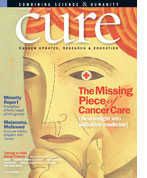Publication
Article
CURE
Bearing the Bankruptcy Burden
Author(s):
To combat medical indebtedness, some cancer survivors are ending up in bankruptcy court.
To combat medical indebtedness, some survivors of cancer and other catastrophic illnesses are ending up in bankruptcy court. A 2005 study published in the journal Health Affairs estimated that medical bankruptcies affect about 2 million Americans every year, including not just debtors, but their dependents.
Bankruptcy laws enable people who can no longer pay their creditors to begin their financial lives again, usually by creating a manageable repayment plan.
Cancer survivors in bankruptcy court have the highest annual out-of-pocket medical expenses of all medical cases, averaging $35,000 per patient, according to figures from The University of Texas M.D. Anderson Cancer Center.
Despite changes in bankruptcy law in 2005, medical debt still can be discharged, whether it’s on credit cards or with care providers, says Mark Scarberry, Pepperdine University law professor and fall 2007 resident scholar at the American Bankruptcy Institute. “The usual result is it will be discharged, so the patient won’t be responsible for it anymore, and the doctors and hospital will likely get nothing. But the change in the law has frightened some people away from filing.”
Misinformation about changes in the law is abundant, but Scarberry says that the bankruptcy system is still a very viable option for people with unmanageable debt.
“Look at your debt, and if there is no way to pay it back and maintain a reasonable standard of living, and you see no future way out of it, then it’s probably time,” he says.






